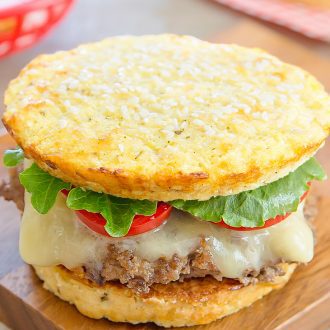 Ingredients
Ingredients
Cauliflower Grits
- 1 head of cauliflower, about 1 pound, yield 4 cups grated
- 1 cup unsweetened cashew milk, or coconut milk or grass-fed whole dairy milk
- 1 tablespoon unsalted grass-fed butter, or ghee
- ¼ cup unsalted chicken stock, or vegetable stock
- ¼ teaspoon kosher salt
- ¼ cup grated organic sharp cheddar cheese
Shrimp
- 1 pound shrimp, peeled and deveined, 16/20 count
- ¼ teaspoon kosher salt, divided
- ⅛ teaspoon black pepper
- ⅛ teaspoon cayenne pepper
- ⅛ teaspoon paprika
- 4 slices nitrate free bacon, thick-cut, chopped into ½-inch pieces
- 1 tablespoon minced garlic, about 4 cloves
- ¼ cup yellow onion, diced into ¼-inch cubes
- ¼ cup red bell pepper, diced into ¼-inch cubes
- 2 tablespoons olive oil, to substitute bacon grease if desired
- 4 teaspoons lemon juice
- ¼ cup green onions, thinly sliced
Greens
- 8 ounces Swiss chard, sliced into 1-inch strips
Instructions
Cauliflower Grits
- Grate or add cauliflower florets to a food processor. You want the cauliflower to be about the size of rice grains. See the video linked here.
- Add cauliflower to a medium-sized saute pan and cook over medium-high heat for about 5 minutes, constantly stirring to release some moisture from the vegetable.
- Add one tablespoon of butter, ¼ cup of cashew milk, ¼ cup of chicken stock, and ¼ teaspoon salt. Stir and cook until moisture gets absorbed and cauliflower cooks through about 5 minutes.
- Using an immersion hand blender or blender, pulse cauliflower mixture until it resembles the texture of grits (smooth yet still grainy). You don’t want the mixture to be completely smooth.
- Transfer back to the pan. Turn heat to medium and add in ¼ cup grated cheese, stir until melted. Slowly add about ½ to ¾ cup more cashew milk until the grits are smooth and creamy. Taste and season with more salt and pepper as desired. Keep warm over very low heat while making the shrimp.
Spicy Shrimp
- In a medium-sized bowl combine shrimp, ¼ teaspoon salt, ⅛ teaspoon pepper, ⅛ teaspoon cayenne pepper, and ⅛ teaspoon paprika. Set aside. You can add more cayenne pepper if you like it really spicy.
- Heat a large saute pan over medium-high heat. Add diced bacon and cook until crispy, frequently stirring about 6 minutes. Transfer to a paper towel and drain. Keep 2 tablespoons of bacon grease in the pan, or you can remove and use 2 tablespoons of olive oil instead.
- Heat pan to medium and add garlic and onion, stir and cook for 1 minute until fragrant. Add in the bell peppers and cook for 1 minute.
- Turn heat to medium-high and add shrimp. Cook for 2 minutes on one side, and 1 minute on the other until pink. Add in 4 teaspoons of lemon juice, 2 tablespoons green onions, and cooked bacon. Stir to combine, cook for about 1 minute. Transfer shrimp to a warm bowl.
Greens
- In the same pan add the swiss chard. Cook on medium-high heat until wilted and tender, about 3 to 4 minutes. Season with salt and pepper.
To Serve: Stir and reheat grits if needed. Divide grits, greens, and shrimp evenly among serving bowls.

 Decades of scientific research on weight loss have uncovered a few key pieces of information on what helps people successfully win the battle of the bulge.
Decades of scientific research on weight loss have uncovered a few key pieces of information on what helps people successfully win the battle of the bulge. Ingredients:
Ingredients: Ingredients
Ingredients Ingredients
Ingredients Ingredients:
Ingredients: INGREDIENTS
INGREDIENTS Calories are not the issue…where those calories come from IS!
Calories are not the issue…where those calories come from IS! Amp up your veggie intake by using thin slices of Zucchini instead of tortillas to wrap your enchiladas.
Amp up your veggie intake by using thin slices of Zucchini instead of tortillas to wrap your enchiladas.
